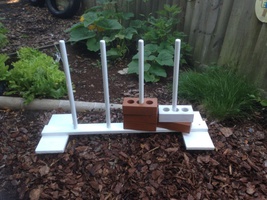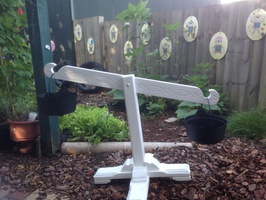
Early Years Pupil Premium & Deprivation Funding
The aim of the Early Years Pupil Premium is to close the gap between children from disadvantaged backgrounds and other children by providing additional funding to settings such as ours, therefore providing the opportunity to raise the quality of provision we offer.
All children aged three and four (not two year olds), who meet the eligibility criteria will benefit from the funding. This funding is paid directly to us on an hourly rate basis, linked to claimed hours for entitled children. The annual value for a 15 hour place over a full year is just over £300 and since we are registered to offer early years places we can receive the EYPP. In order to be able to claim this funding we require parents to sign the funding agreement which asks for details of parent’s date of birth and National Insurance number.
Deprivation Supplement Funding payments are based on children's postcode data and is not child specific. It is used in our setting to support vulnerable children, children with additional needs and to help us to provide an inclusive service.
Which three-and four-year-olds will be eligible for the EYPP?
A child will be eligible for the EYPP if they:
- Are in a low-income family and their parents are in receipt of benefits (one or more), for example, Child Tax Credit and Income Support;
- Have been adopted from care;
- Have left care through special guardianship;
- Have been looked after by the local authority for at least the span of one day;
- Are subject to a child arrangement order.
As an Early Years setting we have the freedom to choose how we spend the money to best support disadvantaged children in our care. Our pre-school will use the additional funding in the following ways:
- Select relevant services from the ‘Early Years charged offer to private and voluntary (PV) early year’s providers’ available from Cambridgeshire Early Years.
- Continue our commitment to furthering our knowledge within our Continuing Professional Development by attending relevant training.
- Provide home visits to families that include an ‘educational gift’ which aids transition into our setting.
- Creating ‘Home/Setting’ lending bags and boxes.
- Buy in any specialist services to support families and children (this includes the cost of staffing such events), such as, healthy cooking, parenting classes and information awareness sessions.
- Providing additional staff to allow us to provide more acceptable child:adult ratios.
- Purchasing additional resources.
Measuring the impact of the EYPP.
We are continually reviewing the data we collect on children’s attainment and refreshing our strategies to support children who are falling behind or in danger of doing so. The practical ideas that are implemented on a daily basis are only a few of the strategies used and their success can be monitored through the data. However, there are other ways that we measure and monitor the impact we have on families. These are:
- Parent questionnaires;
- Informal conversations at the start or end of a day;
- Parent feedback forms provided with children’s Learning Journals;
- Formal consultations;
- Success after the implementation of the Early Help Assessments (EHA’s);
- Conversations with professionals we work alongside to support families;
-
Feedback from feeder primary schools;
-
Every Child a Talker (ECAT) data.
The story so far …
We have found in the past that several families have gone through difficult times such as separation, struggling to make ends meet and even bereavement. Having spoken to other settings who are experiencing a similar trend we decided to organise and host an evening training session that covered ‘Bereavement, loss and separation’ using some of the EYPP money. As a result of this training we have written a policy that will help all staff and families understand our settings viewpoint. By providing this opportunity for several settings to come together we hope it has given them the tools and knowledge to help such families navigate these difficult times. This training has identified various resources that future EYPP money could be used for. With COVID still very much around this training will be beneficial going forward.
Literacy and maths are often areas that are highlighted and we have used some of the funding to make improvements to our outdoor area. Since some of the improvements can be costly we tend to look to the community and especially parents and extended family to assist. Recently a talented grandparent turned some wood we sourced into large balancing scales for our outdoor area and tree trunks into seats, therefore meeting both areas of learning.
We bought the resources to make a water wall to encourage children in their mathematical development. It proved popular and more than a little wet! Mark making takes many forms in our garden and below you can see how we use twigs and sand in the tuff spot and shaving foam to encourage children to explore making marks using different materials.
Transitions in…
We carry out a Home Visit as standard before a child starts (Manager and the child’s allocated key-worker). A transitional gift is used to assist the key-worker to engage with the child in the knowledge they are close to their trusted adult. This gift includes:
-
A book bag
-
2 children’s stories
-
Set of crayons & plain paper
-
NSPCC leaflets on a variety of subjects, including keeping children safe
-
Leaflets devised by us covering ideas for literacy and mathematics in everyday routines at home.
-
An Entry Point questionnaire to get us started on what children can do.
-
A ‘Getting to Know You’ booklet devised after ideas shared whilst networking after training.
and out…
We discuss how the transition into the setting will go ahead using parent’s knowledge of their children to guide us. Sometimes it has been as simple as printer paper, ink and photos where we have designed a booklet to aid a child (and on occasion children from other settings) in their transition into school. We are in the process of improving this to make it more child friendly and adopt a ‘story’ theme instead of it merely being factual. We plan to develop one for families to use as they prepare to enter our setting possibly using pictures of their child from the initial visit.
The Reception teacher at Alderman Payne Primary school commented...
"Children came into school leaving their parents straight away and were confident understanding the classroom rules...the children sat beautifully on the carpet showing that they were ready to listen for the register. Most children had good fine motor skills and I could see that the children had been introduced to sound work."
Comments from parents include…
“We have noticed loads of improvements since our son started in September.”
“D…is very happy and settled. She is finding herself and continues to surprise every day. For us she is a breath of fresh air and is growing into a great little girl ready to take on school next year.”
We were excited to be interviewed by Charlotte Goddard who wrote an article on Early Years Pupil Premium which was published in Nursery World educational magazine in October 2015. We were also cited on the Early Education website under a section called ‘Including families in your decision making’ for examples of partnership working'.


